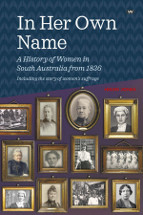In her own name : A history of women in South Australia from 1836 by Helen Jones

Wakefield Press, 2020. ISBN: 9781743056981.
Recommended. Helen Jones first published this remarkable book in
1986, with a second edition published in 1994, and this third
edition published in 2020. The book has grown over those years and
this current edition is a large paperback of 387 pages of history,
with a further set of supporting data that is 1/3 of the book's size
in total. This most outstanding work is a weighty tome, both
fascinating and enlightening regarding the way that women developed
their own lives, from education, preparation for work, and
motherhood, to being married, running a household, or continuing in
their education, and gaining the right to not only vote in the
elections of Members of Parliament, but eventually to be able to
stand themselves for a seat in Parliament. Supporting structures are
explored, particularly as they were instituted to enable the women
to work and learn, and to have their children cared for, initially,
and then educated, in South Australia over the period of time from
1836 to 2020.
Accessing an extraordinary amount of data, much of which is
included, Helen Jones has presented a 'story' that covers the world
of women from very early settlement to the current times. It is
important to note that her work is supported with documentation that
includes names, dates, places and purpose. In that we are given
evidence of the way that women were able to develop lives, often in
ways that had been historically taboo, this book delves into the
various categories of education available to the different needs of
young women, particularly noting that State education has been free
in South Australia. Schools, both state and private, are shown to
have played a strong part in both the development of a strong system
of education available for girls, and in the preparation of young
women to train as teachers from quite early in the colony.
This extraordinary book is a riveting read, both in its attention to
detail, and in its breadth of data. It would be a stunning book for
students to access in learning about this state and enabling access
to real details of the history of women in South Australia. Thus it
would be ideal for study both as an historical document, and as a
source of data that proves just how deeply women were involved, from
its beginning, in the development of South Australia.
Elizabeth Bondar